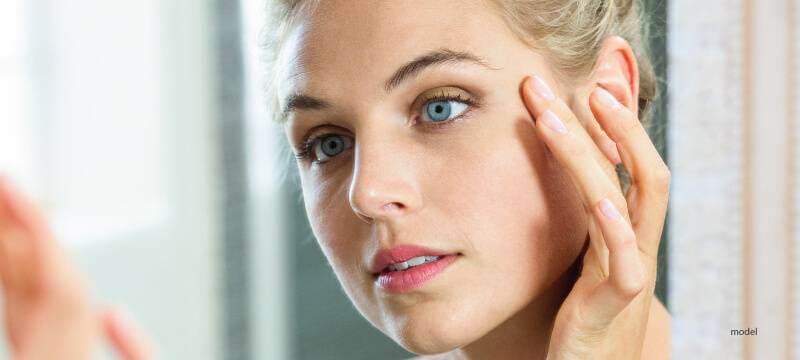Under Eye Bags: Causes, Prevention, and Treatments

Bags under the eyes are one of the biggest aesthetic complaints our patients commonly cite. While typically not impairing vision or being harmful to one’s health, under-eye bags can make the eyes appear puffy, tired, and dramatically older. While eye bags can be the result of the natural aging process, there are several effective preventative and treatment options to keep restore a more youthful appearance to the eye.
If you are struggling with under eye puffiness or discoloration, please continue reading this post to learn more about getting rid of under-eye bags.
What are Under Eye Bags?
Eye bags manifest as swollen or puffy appearing pouches or pads of fat under the eyes. They are the result of a noticeable buildup of skin, fat, and other tissue under the eyes. In their severe form, under eye bags become exacerbated by excess fluids that also pool in the area. This can result in further swelling, puffiness, and swelling. Many people will notice that eye bags tend to be most prominent in the morning. This is due to the overnight pooling of fluids in the area.
Enlarged eye bags creates shadows and discoloration in the undereye also known as dark circles. The undereye can appear darkened or even bruised. For individuals with thin or delicate skin, under eye bags can also cause blood vessels in the area to become more visible.
Under eye bags typically appear in our 40’s and 50’s, although there are lifestyle habits that can increase the likelihood, they’ll show up sooner. It’s not unheard of for individuals to begin experience the formation of eye bags in their 20’s.
While eye bags are usually not a cause for concern, you should see your primary care physician if you experience a persistent swelling, pain, itchy sensation or redness in the area.
What Causes Under Eye Bags?
Aging is the primary cause of under eye bags. As the skin naturally ages it experiences a loss of skin firming proteins such as collagen and elastin. Lower levels of collagen create a loss of elasticity and tone in both the skin and underlying facial muscles. Sagginess of the skin occurs, especially in the under eye where the skin is very thin. Over time a “pouch” begins to form and the fat pads located under the eyes begins to slip down to fill the space. Fluids can also pool in the area making the lower lids appear even more swollen and puffy.
There are, however several other factors that either play a role in eye bag development or further exasperate their appearance including:
Genetics
If under eye bags run in your family, you’re more susceptible to seeing them as you age. For some, they’re just part of the natural aging process. Individuals with thinner skin or weaker under-eye muscles will develop more severe eye bags.
Lifestyle Choices
Tanning (both naturally or through an indoor tanning bed), smoking cigarettes, and excessive alcohol can directly accelerate aging and diminish collagen production.
Lack of Sleep
When we sleep, the fluid in and around the eyes is circulated to keep our eyes hydrated and healthy. Too little sleep can leave us waking up with a puffy or swollen look. In extreme cases, the tiny blood vessels under the eyes burst, mixing blood with this fluid and leading to dark under eye circles.
Water Retention
A high salt diet causes the body to retain water, which can lead to swelling under the eyes. Water retention may also be related to hormonal changes, especially those that occur as we get older.
Allergies
Sinus congestion can lead to congestion in the veins under the eyes, which may cause swelling or dark circles. Allergies also cause inflammation which can increase puffiness under the eyes.
Medical Conditions
Under eye bags are usually harmless, but you do want to rule out a medical condition. Under eye bags might result from blocked tear ducts, eye infections, injury or trauma to the eye, or thyroid disease.
Preventing Under Eye Bags
Unfortunately, there is no full proof way to prevent under eye bags. However, by taking good care of the skin and living a healthy lifestyle can minimize or delay the development of eye bags.
To prevent under eye bags or to treat them at home, try the following:
- Get between 7-9 hours of beauty sleep nightly
- Sleep with your head slightly elevated to prevent fluid from pooling
- Stay hydrated and minimize your sodium intake by avoiding salty foods to prevent fluid retention
- Seek treatment for allergies if necessary
- Apply a cold compress, chilled cucumber slices or cold/damp tea bags under your eyes for 10-15 minutes each morning
- Consistently use a high-quality anti-aging eye cream and (if possible) store it in the fridge so it goes on cool to further reduce swelling
- Use fingertips to gently massage or tap on eye bags to help circulate fluid
- If you smoke, quit. Smoking can irritate your eyes and ages your skin
- Practice safe sun care, always use a high SPF broad spectrum sunscreen and consider wearing sunglasses and a wide-brimmed hat to minimize UV exposure when outdoors.
Under Eye Bags Treatment Options
There are numerous non-surgical cosmetic treatments with the ability to correct eye bags including dermal fillers, laser resurfacing, chemical peels. For severe eye bags, plastic surgery may be necessary.
Here are today’s most effective treatment options:
Laser Resurfacing
Skin resurfacing lasers uses heat to remove the oldest, top layer of skin which reveals the youthful skin cells below. This procedure stimulates collagen production and results in firmer skin. Firming the skin in this way makes under eye bags less apparent.
Results should be immediately noticeable and can last for years, depending upon the severity of your under-eye bags.
Microneedling
Microneedling can be combined with a CO2 laser treatment, or applied on its own. This method of skin resurfacing uses tiny needles to cause micro-damage to the top layer of skin. The healing process stimulates collagen and elastin production for more firm and plump skin.
Because it stimulates collagen production, the final results of microneedling may take several months to appear. Patients typically receive 2-4 treatments, at 4-8 weeks apart.
Dermal Fillers
Injecting dermal fillers into the under-eye or cheek area can soften the appearance of under eye bags. These gel-like substances contain hyaluronic acid which promotes collagen production, but they also work immediately by adding volume under the skin.
Dermal fillers require no down time, patients can even get a filler treatment during their lunch break and return to work. Results can last for up to 1 year or longer if the patient choose to undergo periodic “maintenance” treatment sessions.
Eyelid Surgery
Eyelid surgery, or blepharoplasty, is a plastic surgery procedure with the ability to correct even the most severe eye bags. This outpatient procedure tightens the muscles and skin under the eyes which repositions the fat pockets that cause the appearance of bags.
Blepharoplasty yields dramatic results that are permanent. However, the procedure does require downtime. Patients may need up to 7-10 days to return to work and normal daily activity and 4-6 weeks for the area to fully recover.
Disclaimer: The contents of the Westlake Dermatology website, including text, graphics, and images, are for informational purposes only and are not intended to substitute for direct medical advice from your physician or other qualified professional.

Dermalmd under eye serum works on dark circles its effect is very slow you need to be patient with the use and need to use it daily for results and I prefer using it before sleep rather than in the afternoon I’m in love with this serum